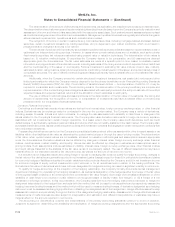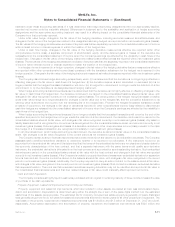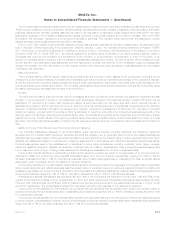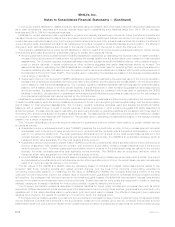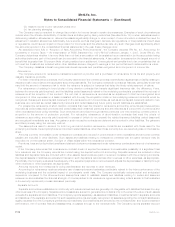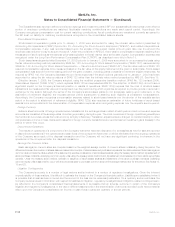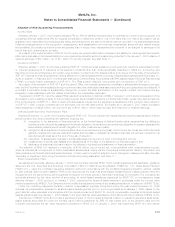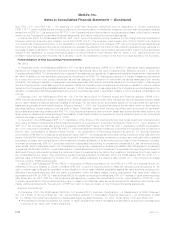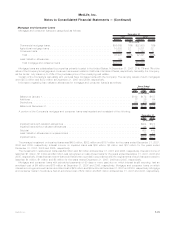MetLife 2007 Annual Report Download - page 116
Download and view the complete annual report
Please find page 116 of the 2007 MetLife annual report below. You can navigate through the pages in the report by either clicking on the pages listed below, or by using the keyword search tool below to find specific information within the annual report.forward in the provisions of SFAS 123(r), the Company discloses the pro forma impact as if stock-based awards accounted for under APB
25 had been accounted for under the fair value method in Note 18.
SFAS 123 allowed forfeitures of stock-based awards to be recognized as a reduction of compensation expense in the period in which
the forfeiture occurred. Upon adoption of SFAS 123(r), the Company changed its policy and now incorporates an estimate of future
forfeitures into the determination of compensation expense when recognizing expense over the requisite service period. The impact of this
change in accounting policy was not significant to the Company’s financial position or results of operations as of the date of adoption.
Additionally, for awards granted after adoption, the Company changed its policy from recognizing expense for stock-based awards over
the requisite service period to recognizing such expense over the shorter of the requisite service period or the period to attainment of
retirement-eligibility. The pro forma impact of this change in expense recognition policy for stock-based compensation is detailed in
Note 18.
Prior to the adoption of SFAS 123(r), the Company presented tax benefits of deductions resulting from the exercise of stock options
within operating cash flows in the consolidated statements of cash flows. SFAS 123(r) requires tax benefits resulting from tax deductions in
excess of the compensation cost recognized for those options be classified and reported as a financing cash inflow upon adoption of
SFAS 123(r).
Derivative Financial Instruments
The Company has adopted guidance relating to derivative financial instruments as follows:
kEffective January 1, 2006, the Company adopted prospectively SFAS No. 155, Accounting for Certain Hybrid Instruments
(“SFAS 155”). SFAS 155 amends SFAS 133 and SFAS No. 140, Accounting for Transfers and Servicing of Financial Assets and
Extinguishments of Liabilities (“SFAS 140”). SFAS 155 allows financial instruments that have embedded derivatives to be accounted
for as a whole, eliminating the need to bifurcate the derivative from its host, if the holder elects to account for the whole instrument on
a fair value basis. In addition, among other changes, SFAS 155:
(i) clarifies which interest-only strips and principal-only strips are not subject to the requirements of SFAS 133;
(ii) establishes a requirement to evaluate interests in securitized financial assets to identify interests that are freestanding derivatives
or that are hybrid financial instruments that contain an embedded derivative requiring bifurcation;
(iii) clarifies that concentrations of credit risk in the form of subordination are not embedded derivatives; and
(iv) amends SFAS 140 to eliminate the prohibition on a qualifying special-purpose entity (“QSPE”) from holding a derivative financial
instrument that pertains to a beneficial interest other than another derivative financial interest.
The adoption of SFAS 155 did not have a material impact on the Company’s consolidated financial statements.
kEffective October 1, 2006, the Company adopted SFAS 133 Implementation Issue No. B40, Embedded Derivatives: Application of
Paragraph 13(b) to Securitized Interests in Prepayable Financial Assets (“Issue B40”). Issue B40 clarifies that a securitized interest in
prepayable financial assets is not subject to the conditions in paragraph 13(b) of SFAS 133, if it meets both of the following criteria:
(i) the right to accelerate the settlement if the securitized interest cannot be controlled by the investor; and (ii) the securitized interest
itself does not contain an embedded derivative (including an interest rate-related derivative) for which bifurcation would be required
other than an embedded derivative that results solely from the embedded call options in the underlying financial assets. The adoption
of Issue B40 did not have a material impact on the Company’s consolidated financial statements.
kEffective January 1, 2006, the Company adopted prospectively SFAS 133 Implementation Issue No. B38, Embedded Derivatives:
Evaluation of Net Settlement with Respect to the Settlement of a Debt Instrument through Exercise of an Embedded Put Option or Call
Option (“Issue B38”) and SFAS 133 Implementation Issue No. B39, Embedded Derivatives: Application of Paragraph 13(b) to Call
Options That Are Exercisable Only by the Debtor (“Issue B39”). Issue B38 clarifies that the potential settlement of a debtor’s obligation
to a creditor occurring upon exercise of a put or call option meets the net settlement criteria of SFAS 133. Issue B39 clarifies that an
embedded call option, in which the underlying is an interest rate or interest rate index, that can accelerate the settlement of a debt
host financial instrument should not be bifurcated and fair valued if the right to accelerate the settlement can be exercised only by the
debtor (issuer/borrower) and the investor will recover substantially all of its initial net investment. The adoption of Issues B38 and B39
did not have a material impact on the Company’s consolidated financial statements.
Other
Effective January 1, 2007, the Company adopted FASB Staff Position (“FSP”) Emerging Issues Task Force (“EITF”) 00-19-2, Accounting
for Registration Payment Arrangements (“FSP EITF 00-19-2”). FSP EITF 00-19-2 specifies that the contingent obligation to make future
payments or otherwise transfer consideration under a registration payment arrangement should be separately recognized and measured in
accordance with SFAS No. 5, Accounting for Contingencies. The adoption of FSP EITF 00-19-2 did not have an impact on the Company’s
consolidated financial statements.
Effective January 1, 2007, the Company adopted FSP No. FAS 13-2, Accounting for a Change or Projected Change in the Timing of
Cash Flows Relating to Income Taxes Generated by a Leveraged Lease Transaction (“FSP 13-2”). FSP 13-2 amends SFAS No. 13,
Accounting for Leases, to require that a lessor review the projected timing of income tax cash flows generated by a leveraged lease
annually or more frequently if events or circumstances indicate that a change in timing has occurred or is projected to occur. In addition,
FSP 13-2 requires that the change in the net investment balance resulting from the recalculation be recognized as a gain or loss from
continuing operations in the same line item in which leveraged lease income is recognized in the year in which the assumption is changed.
The adoption of FSP 13-2 did not have a material impact on the Company’s consolidated financial statements.
Effective January 1, 2007, the Company adopted SFAS No. 156, Accounting for Servicing of Financial Assets — an amendment of
FASB Statement No. 140 (“SFAS 156”). Among other requirements, SFAS 156 requires an entity to recognize a servicing asset or servicing
liability each time it undertakes an obligation to service a financial asset by entering into a servicing contract in certain situations. The
adoption of SFAS 156 did not have an impact on the Company’s consolidated financial statements.
F-20 MetLife, Inc.
MetLife, Inc.
Notes to Consolidated Financial Statements — (Continued)


